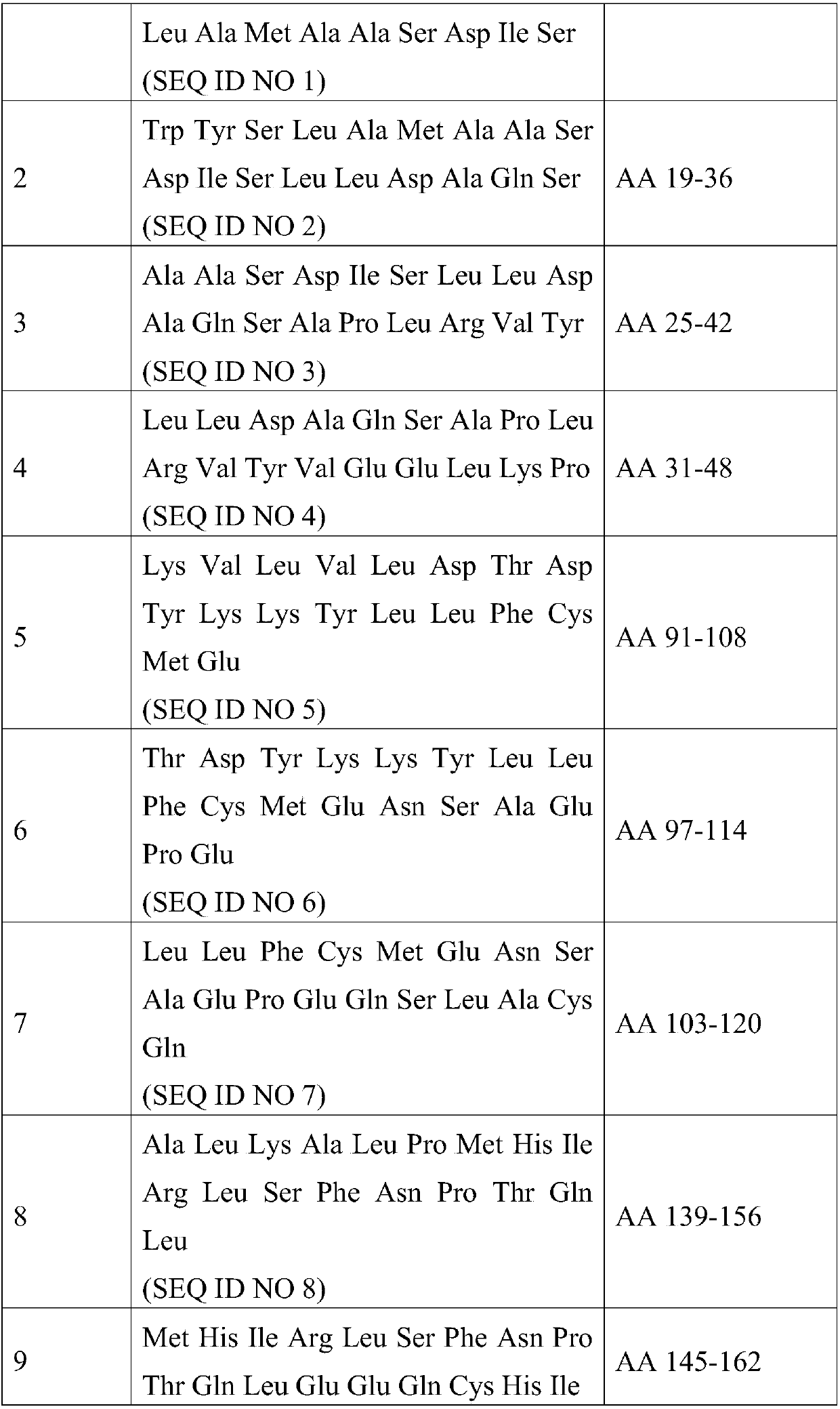Beta-lactoglobulin peptide for treating cow's milk protein allergy
A technology of lactoglobulin and milk protein, applied in the direction of protein-containing food ingredients, peptides, applications, etc., can solve the problems of infants who are not suitable for milk allergies
- Summary
- Abstract
- Description
- Claims
- Application Information
AI Technical Summary
Problems solved by technology
Method used
Image
Examples
Embodiment 1
[0088] Peptide selection
[0089] An 18 amino acid long synthetic peptide with a 12 amino acid overlap spanning the β-lactoglobulin B variant and 6 polymerized peptides of the β-lactoglobulin A variant was obtained from JPT Peptide Technologies (Berlin, Germany).
[0090] Peptides were synthesized and pre-screened by analysis of T cell lines. 25 B cells transformed with 18-Epstein Barr virus (EBV) were cultured in RPMI 1640-GlutaMAX supplemented with 10% heat-inactivated FBS and 2% Pen / Strep TM-I. Milk-specific T cell lines (TCLs) were generated as previously described by Schade et al. (2000, J Allerg. Clin. Immunol. 106:1155-62). TCL was cultured in Yssel medium containing 2% HS, 2% Pen / Strep, 1% Glut, 50IU / ml IL-2 and 50IU / ml IL-4, and re-stimulated with milk every two weeks to maintain it in medium. For restimulation, autologous EBV-transformed B cells were pre-incubated overnight with 50 μg / ml bovine milk protein mixture. Subsequently, B cells were irradiated and adde...
Embodiment 2
[0102] Treatment of whey protein-allergic mice with β-lactoglobulin peptides results in absence of anaphylaxis
[0103] Three-week-old pathogen-free female C3H / HeOuJ mice (Charles River Laboratories, Maastricht, The Netherlands) were used in this experiment. Mice were fed standard mouse chow without bovine milk protein (AIN-93G soybean, Special Diets Services, Wijk bij Duurstede, Netherlands). They were housed in the animal house of the University of Utrecht and handled according to the guidelines of the Dutch Committee for Animal Experiments.
[0104] Whey protein was obtained from DMV International (Veghel, The Netherlands). Partial whey hydrolyzate (pWH) is produced by enzymatic hydrolysis at the Danone Research Center for Specialty Nutrition under the specific conditions described below. 19.5 kg of 12° C. demineralized water (hereinafter referred to as "demineralized water") was placed in a tank and mixed with 4.1 kg of demineralized whey (Deminal, Friesland Foods Domo) ...
Embodiment 3
[0118] Infant formula for infants with cow's milk allergy
[0119] Energy density: 0.6-0.77kcal / ml; lipid: 5.5 to 7g / 100ml ready-to-eat formula milk powder. The protein exists in the form of free amino acids as well as the β-lactoglobulin peptides of the invention. The mixture of peptides as tested in Example 2 was present at approximately 100 μg per g of protein.
[0120] nutritional information
per 100g powder
per 100kcal*
per 100ml**
Energy kJ
2918
413
292
kcal
707
100
70.7
protein g
15.2
2.1
1.5
carbohydrate g
7.6
1.1
0.76
[0121]
[0122]
[0123]
[0124] The composition further comprises vegetable and microbial fats with 0.2 wt% DHA based on total fat.
PUM
| Property | Measurement | Unit |
|---|---|---|
| molecular weight | aaaaa | aaaaa |
| viscosity | aaaaa | aaaaa |
Abstract
Description
Claims
Application Information
 Login to View More
Login to View More - R&D
- Intellectual Property
- Life Sciences
- Materials
- Tech Scout
- Unparalleled Data Quality
- Higher Quality Content
- 60% Fewer Hallucinations
Browse by: Latest US Patents, China's latest patents, Technical Efficacy Thesaurus, Application Domain, Technology Topic, Popular Technical Reports.
© 2025 PatSnap. All rights reserved.Legal|Privacy policy|Modern Slavery Act Transparency Statement|Sitemap|About US| Contact US: help@patsnap.com



